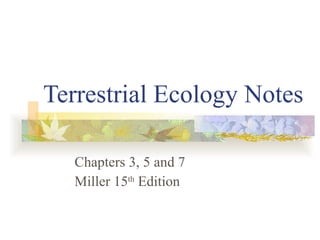
Terrestrial ecology notes1
- 1. Terrestrial Ecology Notes Chapters 3, 5 and 7 Miller 15 th Edition
- 17. Fig. 3-2, p. 51 Communities Subatomic Particles Atoms Molecules Protoplasm Cells Tissues Organs Organ systems Organisms Populations Populations Communities Ecosystems Biosphere Earth Planets Solar systems Galaxies Universe Organisms Realm of ecology Ecosystems Biosphere
- 27. Fig. 3-11, p. 58 Zone of intolerance Optimum range Zone of physiological stress Zone of physiological stress Zone of intolerance Temperature Low High No organisms Few organisms Upper limit of tolerance Population size Abundance of organisms Few organisms No organisms Lower limit of tolerance
- 29. A: Represents the biotic potential of the species B: Shows how the population overshoots the carrying capacity C: Represents the logistic growth D: Represents linear growth E: Carrying capacity- the maximum number of individuals that can be supported by a particular ecosystem.
- 38. Fig. 3-14, p. 61 Abiotic chemicals (carbon dioxide, oxygen, nitrogen, minerals) Heat Heat Heat Heat Heat Solar energy Consumers (herbivores, carnivores) Producers (plants) Decomposers (bacteria, fungi)
- 40. Fig. 3-17, p. 64 Heat Heat Heat Heat Heat Heat Heat Heat Detritivores (decomposers and detritus feeders) First Trophic Level Second Trophic Level Third Trophic Level Fourth Trophic Level Solar energy Producers (plants) Primary consumers (herbivores) Secondary consumers (carnivores) Tertiary consumers (top carnivores)
- 54. Fig. 7-9a, p. 154 (a) Oxpeckers and black rhinoceros
- 63. Fig. 3-7, p. 55 Nitrogen cycle Biosphere Heat in the environment Heat Heat Heat Phosphorus cycle Carbon cycle Oxygen cycle Water cycle
- 64. CARBON CYCLE
- 69. Nitrogen Cycle
- 75. The Sulfur Cycle Figure 3-32
- 83. Earth’s Current Climate Zones Figure 5-2
- 85. BIOMES: CLIMATE AND LIFE ON LAND Figure 5-9
- 110. Secondary begins in an area where the natural community has been disturbed, removed, or destroyed, but soil or bottom sediments remain.
- 114. Water – bare bottom small/few underwater vegetation temporary pond and prairie forest and swamp
- 117. Fig. 5-26, p. 123 Natural Capital Degradation Desert Large desert cities Soil destruction by off-road vehicles Soil salinization from irrigation Depletion of groundwater Land disturbance and pollution from mineral extraction
- 118. Fig. 5-27, p. 123 Oil production and off-road vehicles in arctic tundra Overgrazing by livestock Release of CO 2 to atmosphere from grassland burning Conversion to cropland Grasslands Natural Capital Degradation
- 119. Fig. 5-28, p. 124 Clearing for agriculture, livestock grazing, timber, and urban development Conversion of diverse forests to tree plantations Damage from off-road vehicles Natural Capital Degradation Forests Pollution of forest streams
- 120. Fig. 5-29, p. 124 Natural Capital Degradation Mountains Agriculture Timber extraction Mineral extraction Hydroelectric dams and reservoirs Increasing tourism Urban air pollution Increased ultraviolet radiation from ozone depletion Soil damage from off-road vehicles
Hinweis der Redaktion
- Figure 3.2 Natural capital: levels of organization of matter in nature. Ecology focuses on five of these levels.
- Figure 3.11 Natural capital: range of tolerance for a population of organisms, such as fish, to an abiotic environmental factor—in this case, temperature. These restrictions keep particular species from taking over an ecosystem by keeping their population size in check.
- Figure 3.14 Natural capital: the main structural components of an ecosystem (energy, chemicals, and organisms). Matter recycling and the flow of energy—first from the sun, then through organisms, and finally into the environment as low-quality heat—links these components.
- Figure 3.17 Natural capital: a food chain. The arrows show how chemical energy in food flows through various trophic levels in energy transfers; most of the energy is degraded to heat, in accordance with the second law of thermodynamics.
- Figure 7.9 Natural capital: examples of mutualism. (a) Oxpeckers (or tickbirds) feed on parasitic ticks that infest large, thick-skinned animals such as the endangered black rhinoceros. (b) A clownfish gains protection and food by living among deadly stinging sea anemones and helps protect the anemones from some of their predators. (c) Beneficial effects of mycorrhizal fungi attached to roots of juniper seedlings on plant growth compared to (d) growth of such seedlings in sterilized soil without mycorrhizal fungi.
- Figure 3.7 Natural capital: life on the earth depends on the flow of energy (wavy arrows) from the sun through the biosphere and back into space, the cycling of crucial elements (solid arrows around ovals), and gravity , which keeps atmospheric gases from escaping into space and helps recycle nutrients through air, water, soil, and organisms. This simplified model depicts only a few of the many cycling elements.
- Figure 5.26 Natural capital degradation: major human impacts on the world’s deserts. QUESTION: What are three direct and three indirect harmful effects of your lifestyle on deserts?
- Figure 5.27 Natural capital degradation: major human impacts on the world’s grasslands. Some 70% of Brazil’s tropical savanna—once the size of the Amazon—has been cleared and converted to the world’s biggest grain growing area. QUESTION: What are three direct and three indirect harmful effects of your lifestyle on grasslands?
- Figure 5.28 Natural capital degradation: major human impacts on the world’s forests. QUESTION: What are three direct and three indirect effects of your lifestyle on forests?
- Figure 5.29 Natural capital degradation: major human impacts on the world’s mountains. QUESTION: What are three direct and three indirect harmful effects of your lifestyle on mountains?